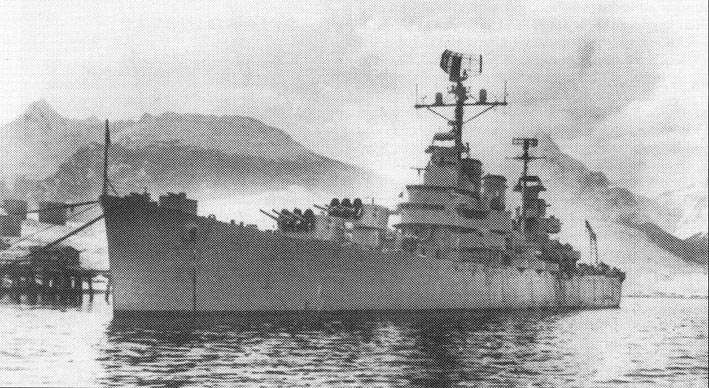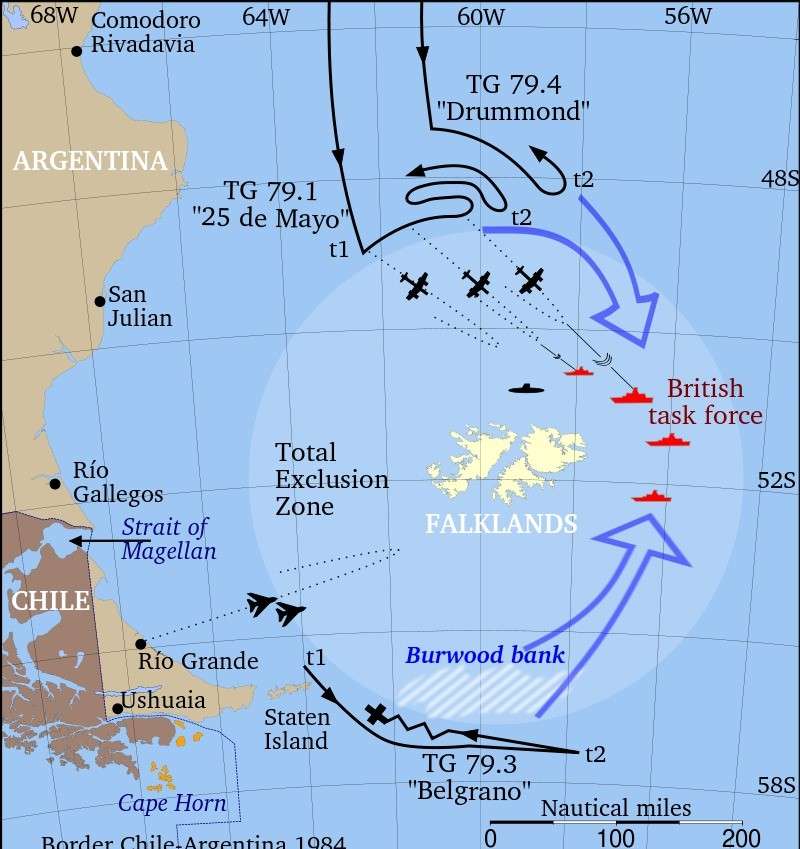On May 2, 1982, the British submarine HMS Conqueror sunk the Argentine cruiser ARA General Belgrano. It remains one of the most controversial incidents in naval history.

The event, which resulted in the loss of over 300 lives, sparked heated debates regarding the legality and proportionality of the attack.
The Falklands
The Falklands War erupted in 1982 when Argentina, under the military junta led by General Leopoldo Galtieri, invaded the Falkland Islands, a British overseas territory.
The conflict unfolded against a backdrop of historical disputes and political ambitions. Argentina had long claimed sovereignty over the Falklands, based on historical precedents and geographic proximity.
The British, on the other hand, maintained their sovereignty over the islands and have had a presence there since the 19th century.
 ARA General Belgrano.
ARA General Belgrano.
Historically, the Falkland Islands have been subject to competing territorial claims between Argentina and the United Kingdom.
The islands are located in the South Atlantic Ocean, approximately 300 miles (480 kilometers) off the coast of South America.
They consist of two main islands, East Falkland and West Falkland, along with numerous smaller islands.
The British Government, 8,000 miles away (12,800 km), under Prime Minister Margaret Thatcher, responded swiftly to the Argentine invasion.
A military task force, consisting of naval vessels, troops, and air support, was dispatched to reclaim the islands. The conflict marked the first major military engagement between two modern powers since World War II.
The historical and political context surrounding the Falklands War provides a backdrop for understanding the circumstances that led to the sinking of the Belgrano.
The General Belgrano
The Argentine Navy played a significant role in the Falklands War, with the cruiser General Belgrano being one of its key assets.
The Belgrano, originally a United States Navy ship named USS Phoenix, was acquired by Argentina in 1951 and served as a proud symbol of the country’s naval power.
 The USS Phoenix at Pearl Harbor, 1941.
The USS Phoenix at Pearl Harbor, 1941.
As a World War II-era warship, General Belgrano possessed considerable firepower and capabilities.
It was a cruiser armed with fifteen 6-inch guns, torpedoes, and anti-aircraft defenses.
The ship had a long and distinguished history, including participation in the Battle of the River Plate during World War II.
Sinking The Belgrano
In late April, the British task force reached the Falkland Islands and implemented a Total Exclusion Zone (TEZ).
Under this measure, an area spanning 200 nautical miles (230 miles, 370 km) from the Falklands’ center was designated by the Royal Navy as part of the active conflict zone.
A clear message was communicated to all ships and aircraft, irrespective of their nationality, that entering the TEZ carried the risk of being fired upon without prior warning.
 A map of the Falklands, showing the Total Exclusion Zone.
A map of the Falklands, showing the Total Exclusion Zone.
In the afternoon of May 2, 1982, the British submarine HMS Conqueror, under the command of Captain Christopher Wreford-Brown had been tracking the Argentine cruiser for some time, monitoring its movements and assessing potential threats to the British naval forces.
The Belgrano was accompanied by two destroyers. All three vessels were outside of the TEZ and moving west away from the Falklands.
At around 15:00, HMS Conqueror fired three Mark VIII torpedoes toward the Argentine cruiser. Two of the the torpedoes successfully struck the Belgrano, causing severe damage to the ship.
 HMS Conqueror returning from the Falklands.
HMS Conqueror returning from the Falklands.
As a result of the torpedo hits, the Belgrano began to take on water rapidly. Efforts to control the flooding and stabilize the ship were hampered by the magnitude of the damage inflicted.
The cruiser listed to the port side and at 16:24, the Captain of the Belgrano gave the order to abandon ship.
The two ships that were with the Belgrano did not know what had happened to the vessel and continued on their course west.
Over the next two days, a rescue effort was made to save the survivors – Argentine and Chilean ships pulled 772 men from the sea.
The exact number of casualties resulting from the sinking of the Belgrano is a subject of debate.
Official figures indicate that 323 Argentine sailors lost their lives in the incident.
Controversy
The sinking of General Belgrano has been the subject of much debate and controversy, including discussions about the legality and classification of the attack as a war crime.
From the British perspective, the sinking of the Belgrano was considered a lawful military action. The British government justified the attack based on the cruiser’s potential threat to their naval forces.
They argued that the Belgrano was a legitimate military target and its sinking was a proportionate response to ensure the safety of their own forces.
On the other hand, critics of the British action argue that the sinking of General Belgrano constituted a war crime.
They contend that the attack violated the principle of proportionality, as the loss of life resulting from the sinking outweighed the potential threat posed by the cruiser at the time of the attack.
They argue that the ship was moving away from the conflict zone and therefore did not pose an immediate threat to British forces.
The classification of an act as a war crime typically falls within the purview of international legal frameworks, such as the Geneva Conventions and customary international law.
These frameworks establish guidelines and principles for the conduct of armed conflicts and define war crimes as serious violations of those rules.
 ARA General Belgrano sinking after the attack.
ARA General Belgrano sinking after the attack.
In the specific case of the sinking of the Belgrano, no international tribunal or court has formally ruled on whether it constituted a war crime.
As such, the question of whether the sinking can be considered a war crime remains a subject of legal interpretation and debate.
It is essential to recognize that different perspectives and interpretations exist regarding the legality and morality of the attack.
These debates highlight the complexities surrounding the application of international humanitarian law in armed conflicts and the challenges of determining the lawfulness of military actions, especially in dynamic and high-pressure situations such as wartime.
Conclusion
The Falklands conflict officially ended on June 14, 1982, with the surrender of Argentine forces.
The conflict lasted for a total of 74 days, from April 2 to June 14, 1982. After a series of military engagements, including land battles, naval confrontations, and air strikes, British forces successfully recaptured the Falkland Islands, effectively ending the hostilities.
The Argentine military junta, under General Leopoldo Galtieri, announced the decision to surrender, and British forces took control of the islands.
In the context of naval history, the sinking of General Belgrano serves as a somber testament to the destructive power of modern warfare and the profound human cost it can exact.
Its legacy endures in the form of ongoing discussions about military ethics, rules of engagement, and the path to conflict resolution.





